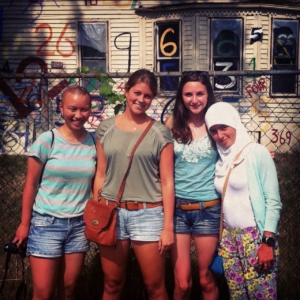
Heidelberg Project, 2012
About five years ago, I spent a Saturday in Detroit with a few high school friends. One friend lived in the city and decided to introduce us to the Heidelberg Project. I remember driving through mostly vacant blocks with old tires stacked on corners and not a person in sight, wondering if we missed a turn. But if you’ve ever seen this place, you know that it’s nearly impossible to miss. Soon, we encountered a whimsical explosion of color. The street was painted, and houses were decorated with everything from numbers and records to polka dots and stuffed animals. Clocks were attached to trees, hundreds of shoes dangled off of a chain link fence, and old children’s toys and kitchen appliances were either carefully placed or basically dumped in piles on adjacent lots. And there were people, lots of them, just wandering around. One of the houses had a big box of markers on the porch and a sign encouraging visitors to leave their names and stories on the wall. I was amazed to find signatures and notes by people from all around the country and the world.
My experience of Detroit was pretty simple back then. It was
Tigers games, Christmas concerts with my cousins, service projects, and the DSO. Heidelberg made me think. I thought about public space, the role of art in a community, and how a few people can take something devastating and turn it into something beautiful.

Heidelberg Project, 2017
A few weeks ago, I went back to Heidelberg with some fellows. Over the past five years, that one block has changed and so has my perspective of Detroit. The site has been a target for 12 suspicious fires that have damaged several houses and brought into focus tensions over the project’s relationship to the community and it’s relationship with the city, which often characterized the installations as junk. This past August, the creator announced that the Heidelberg project will be dismantled, piece by piece over the next two years. It will be replaced with what is being called “Heidelberg 3.0”, a phase that Guyton says will cultivate a larger community. With all of the change happening across the city, from new stadiums and high budget rehabs to new neighborhood development plans, I’m eager to see what the next five years will bring.

